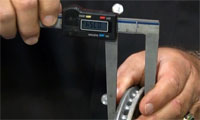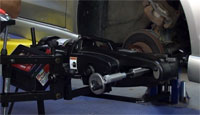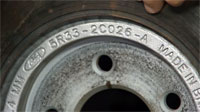Brake Lathes
Although they're one of the most important parts of any brake system, the brake rotors seem to be a true mystery to most people. See they don't know what constitutes a good rotor or a bad rotor and when to replace and so on. Well brake rotors should be checked every time the brake pads are checked. And that means you're going to be doing it every twelve thousand miles, or once a year, or whenever there is a change in the way the brakes feel or sound.
 Now on the back, or sometimes on the front, of all brake rotors, there's going to be a set of measurements that tell you when they have to be replaced. And the way you check them is with a brake micrometer like this. It goes down over the rotor, squeeze it up against the rotor, and it gives you a reading either in inches or in millimeters. And you compare that to the number stamped in the rotor and either it's good or it's bad. Now, if it happens to be bad, what do you do?
Now on the back, or sometimes on the front, of all brake rotors, there's going to be a set of measurements that tell you when they have to be replaced. And the way you check them is with a brake micrometer like this. It goes down over the rotor, squeeze it up against the rotor, and it gives you a reading either in inches or in millimeters. And you compare that to the number stamped in the rotor and either it's good or it's bad. Now, if it happens to be bad, what do you do?
Well, if you start looking at rotors, you'll find that they're all sorts of prices, and you'll usually find that the original equipment tends to be more expensive than some of the aftermarket ones. We see after-market rotors for as little as ten bucks. Well, in most cases there's a big difference in these rotors. Number one: if they're ventilated rotors like this one, the number of fins in here that move air through it, to keep your brakes cool, there may be fewer of them, they may not be as big, they may not be shaped the same as the original equipment. That means your rotors and your pads run hotter; you don't have as effective braking.
The other thing and this is a real big one, the metal that the rotors are made out of, the offshore rotors, the real cheap ones lots of times they have less carbon in them. Less carbon means the metal of the rotor is much softer and it wears away very, very rapidly. We've seen some of them that wear as rapidly as the pads wear. Not a good investment and not safe.
 But suppose you have the original rotors, they're savable but they need to be smoothed out. Well you need to machine the rotors. And I'd advise that instead of buying cheap aftermarket rotors. And for that you would need an on-the-car brake lave, like this Hunter unit that we're demonstrating here. Now, why on-the-car? On-the-car because it compensates for imperfections in the bearings and the other things that are related to the way the rotor turns on the car. If you look at this machine carefully, we haven't compensated it, and we can see that it's jiggling back and forth. That's the amount of imperfection in this rotor. And if we machined it off the car, when we put it on it would be that far out of true for the car.
But suppose you have the original rotors, they're savable but they need to be smoothed out. Well you need to machine the rotors. And I'd advise that instead of buying cheap aftermarket rotors. And for that you would need an on-the-car brake lave, like this Hunter unit that we're demonstrating here. Now, why on-the-car? On-the-car because it compensates for imperfections in the bearings and the other things that are related to the way the rotor turns on the car. If you look at this machine carefully, we haven't compensated it, and we can see that it's jiggling back and forth. That's the amount of imperfection in this rotor. And if we machined it off the car, when we put it on it would be that far out of true for the car.
The other thing is this machine puts a non-directional finish on it. As this machines the rotor, it moves from the center to the outside, and that makes it like a phonograph: a spiral. If you don't do away with that with a non-directional finish you will have noise. So it's a good machine to look for because it takes care of all of those characteristics in one operation.






